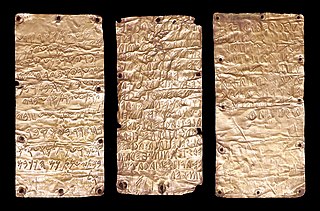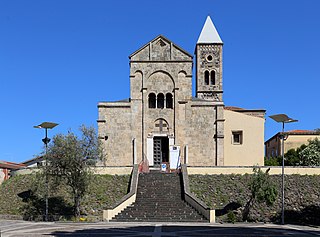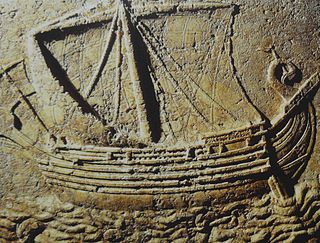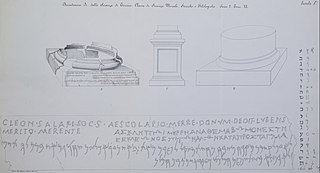The Phoenician alphabet is an abjad used across the Mediterranean civilization of Phoenicia for most of the 1st millennium BC. It was one of the first alphabets, and attested in Canaanite and Aramaic inscriptions found across the Mediterranean region. In the history of writing systems, the Phoenician script also marked the first to have a fixed writing direction—while previous systems were multi-directional, Phoenician was written horizontally, from right to left. It developed directly from the Proto-Sinaitic script used during the Late Bronze Age, which was derived in turn from Egyptian hieroglyphs.

The Pyrgi Tablets are three golden plates inscribed with a bilingual Phoenician–Etruscan dedicatory text. They are the oldest historical source documents from Italy, predating Roman hegemony, and are rare examples of texts in these languages. They were discovered in 1964 during a series of excavations at the site of ancient Pyrgi, on the Tyrrhenian coast of Italy in Latium (Lazio). The text records the foundation of a temple and its dedication to the Phoenician goddess Astarte, who is identified with the Etruscan supreme goddess Uni in the Etruscan text. The temple's construction is attributed to Thefarie Velianas, ruler of the nearby city of Caere.
The Paleo-Hebrew script, also Palaeo-Hebrew, Proto-Hebrew or Old Hebrew, is the writing system found in Canaanite and Aramaic inscriptions, including pre-Biblical and Biblical Hebrew, from southern Canaan, also known as the biblical kingdoms of Israel (Samaria) and Judah. It is considered to be the script used to record the original texts of the Bible due to its similarity to the Samaritan script; the Talmud states that the Samaritans still used this script. The Talmud described it as the "Livonaʾa script", translated by some as "Lebanon script". However, it has also been suggested that the name is a corrupted form of "Neapolitan", i.e. of Nablus. Use of the term "Paleo-Hebrew alphabet" is due to a 1954 suggestion by Solomon Birnbaum, who argued that "[t]o apply the term Phoenician [from Northern Canaan, today's Lebanon] to the script of the Hebrews [from Southern Canaan, today's Israel-Palestine] is hardly suitable". The Paleo-Hebrew and Phoenician alphabets are two slight regional variants of the same script.

Tharros was an ancient city and former bishopric on the west coast of Sardinia, Italy.

Santa Giusta is a comune (municipality) in the Province of Oristano in the Italian region of Sardinia, located about 90 kilometres northwest of Cagliari and about 3 km (2 mi) southeast of Oristano in the Campidano area.

Neapolis was an ancient city of Sardinia founded by the Carthaginians in the sixth century BC, and apparently one of its most important places. It was situated on the west coast, at the southern end of the Gulf of Oristano, at the present-day località of Santa Maria di Nabui, in the comune of Guspini, Province of South Sardinia.

The Nora Stone or Nora Inscription is an ancient Phoenician inscribed stone found at Nora on the south coast of Sardinia in 1773. Though it was not discovered in its primary context, it has been dated by palaeographic methods to the late 9th century to early 8th century BCE and is still considered the oldest Phoenician inscription found anywhere outside of the Levant.

Eshmunazar II was the Phoenician king of Sidon. He was the grandson of Eshmunazar I, and a vassal king of the Persian Achaemenid Empire. Eshmunazar II succeeded his father Tabnit I who ruled for a short time and died before the birth of his son. Tabnit I was succeeded by his sister-wife Amoashtart who ruled alone until Eshmunazar II's birth, and then acted as his regent until the time he would have reached majority. Eshmunazar II died prematurely at the age of 14. He was succeeded by his cousin Bodashtart.

Bodashtart was a Phoenician ruler, who reigned as King of Sidon, the grandson of King Eshmunazar I, and a vassal of the Achaemenid Empire. He succeeded his cousin Eshmunazar II to the throne of Sidon, and scholars believe that he was succeeded by his son and proclaimed heir Yatonmilk.

The Cippi of Melqart are a pair of Phoenician marble cippi that were unearthed in Malta under undocumented circumstances and dated to the 2nd century BC. These are votive offerings to the god Melqart, and are inscribed in two languages, Ancient Greek and Phoenician, and in the two corresponding scripts, the Greek and the Phoenician alphabet. They were discovered in the late 17th century, and the identification of their inscription in a letter dated 1694 made them the first Phoenician writing to be identified and published in modern times. Because they present essentially the same text, the cippi provided the key to the modern understanding of the Phoenician language. In 1758, the French scholar Jean-Jacques Barthélémy relied on their inscription, which used 17 of the 22 letters of the Phoenician alphabet, to decipher the unknown language.

The theory of Phoenician discovery of the Americas suggests that the earliest Old World contact with the Americas was not with Columbus or Norse settlers, but with the Phoenicians in the first millennium BC.
This article presents a history of Cagliari, an Italian municipality and the capital city of the island of Sardinia. The city has been continuously inhabited since at least the neo-lithic period. Due to its strategic location in the Mediterranean and natural harbor, the city was prized and highly sought after by a number of Mediterranean empires and cultures.

Pedra da Gávea is a mountain in Tijuca Forest, Rio de Janeiro, Brazil. Differential weathering on one side of the rock has created what is described as a stylized human face, and weathered markings on another face of the rock have been described as an inscription. Some individuals, such as Bernardo de Azevedo da Silva Ramos, have advanced the position that the inscription is of Phoenician origin and possibly proof of pre-Columbian contact from Old World cultures. Alternative theories proposed include that the rock was the site of a Norse colony or that it is connected with suspected UFO activity.
The following is a timeline of the history of the city of Cagliari, Sardinia, Italy.

The Canaanite and Aramaic inscriptions, also known as Northwest Semitic inscriptions, are the primary extra-Biblical source for understanding of the societies and histories of the ancient Phoenicians, Hebrews and Arameans. Semitic inscriptions may occur on stone slabs, pottery ostraca, ornaments, and range from simple names to full texts. The older inscriptions form a Canaanite–Aramaic dialect continuum, exemplified by writings which scholars have struggled to fit into either category, such as the Stele of Zakkur and the Deir Alla Inscription.

The Pauli Gerrei trilingual inscription is a trilingual Greek-Latin-Phoenician inscription on the base of a bronze column found in San Nicolò Gerrei in Sardinia in 1861. The stele was discovered by a notary named Michele Cappai, on the right side of the Strada statale 387 del Gerrei that descends towards Ballao.
Eshmunazar I was a priest of Astarte and the Phoenician King of Sidon. He was the founder of his namesake dynasty, and a vassal king of the Achaemenid Empire. Eshmunazar participated in the Neo-Babylonian campaigns against Egypt under the command of either Nebuchadnezzar II or Nabonidus. The Sidonian king is mentioned in the funerary inscriptions engraved on the royal sarcophagi of his son Tabnit I and his grandson Eshmunazar II. The monarch's name is also attested in the dedicatory temple inscriptions of his other grandson, King Bodashtart.

Baalshillem I was a Phoenician King of Sidon, and a vassal of the Achaemenid Empire. He was succeeded by his son Abdamon to the throne of Sidon.

Phoenician metal bowls are approximately 90 decorated bowls made in the 7th–8th centuries BCE in bronze, silver and gold, found since the mid-19th century in the Eastern Mediterranean and Iraq. They were historically attributed to the Phoenicians, but are today considered to have been made by a broader group of Levantine peoples.

The Bashamem inscription or Baalshamam inscription is a Phoenician language inscription found in Cagliari, Sardinia in 1877. It is currently in the Museo Archeologico Nazionale di Cagliari.














